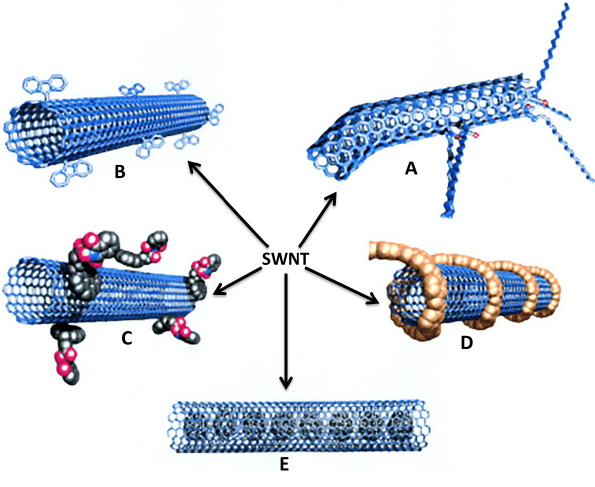Functionalization of Nanomaterials: Enhancing Properties and Expanding Applications
What is Functionalization?
Functionalization is a process of modifying the surface chemistry of nanomaterials by attaching functional groups, molecules, or biomolecules to their surface. This process aims to enhance the properties, compatibility, and performance of nanomaterials for specific applications. Functionalization allows researchers to tailor the surface characteristics, reactivity, and interactions of nanomaterials with their environment.

Types of Functionalization
Functionalization can be achieved through different approaches, depending on the desired surface modifications and the nature of the nanomaterial. The main types of functionalization include:
Covalent Functionalization
Covalent functionalization involves the formation of covalent bonds between the functional groups and the surface atoms of the nanomaterial. This type of functionalization results in a strong and stable attachment of the functional groups, leading to significant changes in the nanomaterial's properties. Examples of covalent functionalization include the attachment of organic molecules, polymers, or biomolecules to the surface of carbon nanotubes, graphene, or quantum dots.
Non-Covalent Functionalization
Non-covalent functionalization relies on weak interactions, such as van der Waals forces, hydrogen bonding, or π-π stacking, between the functional groups and the nanomaterial's surface. This approach preserves the intrinsic properties of the nanomaterial while modifying its surface characteristics. Non-covalent functionalization is particularly useful for applications that require reversible or dynamic interactions, such as drug delivery or sensing.
Biofunctionalization
Biofunctionalization involves the attachment of biological molecules, such as proteins, peptides, or nucleic acids, to the surface of nanomaterials. This type of functionalization enables the development of biocompatible and targeted nanomaterials for biomedical applications, such as imaging, diagnostics, and therapeutics. Biofunctionalization can be achieved through covalent or non-covalent interactions, depending on the desired stability and specificity of the biomolecule attachment.
Techniques for Functionalization
Various techniques can be employed to functionalize nanomaterials, depending on the type of functionalization and the nature of the nanomaterial. Some common techniques include:
- Chemical Modification: This technique involves the use of chemical reactions to attach functional groups to the surface of nanomaterials. Examples include silanization, esterification, and amidation reactions.
- Physical Adsorption: Physical adsorption relies on weak interactions, such as van der Waals forces or hydrogen bonding, to attach functional groups to the nanomaterial's surface. This technique is simple and versatile but may result in less stable functionalization compared to covalent methods.
- Plasma Treatment: Plasma treatment is a surface modification technique that uses ionized gas to create reactive species on the nanomaterial's surface. These reactive species can then be used to attach functional groups or initiate further surface reactions.
- Electrochemical Modification: Electrochemical modification involves the use of electrical potential to drive the attachment of functional groups to the nanomaterial's surface. This technique offers precise control over the functionalization process and can be used for selective functionalization of conductive nanomaterials.
Applications of Functionalized Nanomaterials
Functionalized nanomaterials find applications in a wide range of fields, leveraging their enhanced properties and tailored surface characteristics. Some key applications include:
Biomedical Applications
Functionalized nanomaterials are extensively used in biomedical applications, such as targeted drug delivery, bioimaging, and biosensing. The attachment of targeting ligands, therapeutic agents, or fluorescent probes to the surface of nanomaterials enables the development of smart and responsive nanomedicines. Functionalized MXenes, for example, have shown promising results in cancer therapy and diagnostic imaging.
Catalysis
Functionalized nanomaterials are widely employed as catalysts in various chemical reactions. The high surface area and tailored surface chemistry of functionalized nanomaterials enhance their catalytic activity and selectivity. Functionalized metal nanoparticles, such as gold and platinum, are used in catalytic processes for energy conversion, environmental remediation, and organic synthesis.
Sensors and Actuators
Functionalized nanomaterials are used in the development of highly sensitive and selective sensors and actuators. The attachment of specific receptor molecules or functional groups to the surface of nanomaterials enables the detection of target analytes or the actuation of specific responses. Functionalized nanowires and nanofibers are employed in the fabrication of chemical sensors, biosensors, and electromechanical actuators.
Energy Storage and Conversion
Functionalized nanomaterials play a crucial role in energy storage and conversion devices, such as batteries, supercapacitors, and solar cells. The functionalization of electrode materials with conductive polymers, redox-active molecules, or charge-transfer agents enhances the electrochemical performance and stability of these devices. Functionalized graphene quantum dots, for instance, have shown promising results in high-performance supercapacitors and photovoltaic devices.
Challenges and Future Perspectives
Despite the significant advancements in the functionalization of nanomaterials, several challenges remain to be addressed. One of the main challenges is the precise control over the density, distribution, and orientation of the functional groups on the nanomaterial's surface. The development of advanced characterization techniques and computational tools is crucial for understanding and optimizing the functionalization process.
Another challenge is the scalability and reproducibility of functionalized nanomaterials. The synthesis and functionalization of nanomaterials often involve complex and multi-step processes, which can hinder their large-scale production and commercialization. The development of efficient and cost-effective functionalization methods is essential for the widespread adoption of functionalized nanomaterials in various applications.
Future research in the functionalization of nanomaterials will focus on the development of novel functional groups and attachment strategies for specific applications. The integration of machine learning and high-throughput screening techniques will accelerate the discovery and optimization of functionalized nanomaterials with desired properties. Additionally, the exploration of multi-functional nanomaterials, which combine multiple functionalities in a single nanostructure, will open up new avenues for advanced applications in fields such as theranostics, energy harvesting, and smart materials.
Further Reading
Advanced Energy Materials, Surface-Functionalized Nanoparticles as Catalysts for Artificial Photosynthesis
